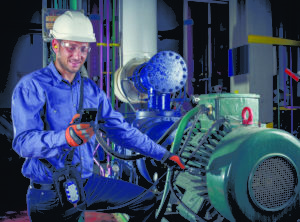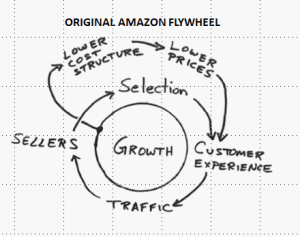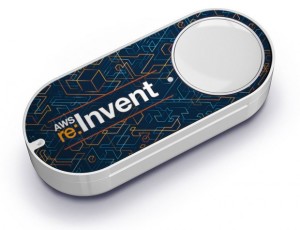Could sound be a critical IoT tool?
I’d fixated in the past on a metaphor I called “Collective Blindness,” as a way to explain how difficult it used to be to get accurate, real-time data about how a whole range of things, from tractors to your body, were actually working (or not) because we had no way to penetrate the surface of these objects as they were used. As a result, we created some not-so-great work-arounds to cope with this lack of information.
Then along came the IoT, and no more collective blindness!
Now I’m belatedly learning about some exciting efforts to use another sense, sound, for the IoT. Most prominent, of course, is Amazon’s Alexa and her buddies (BTW, when I ask Siri if she knows Alexa, her response was an elusive “this is about you, not me,” LOL), but I’ve found a variety of start-ups pursuing quite different aspects of sound. They nicely illustrate the variety of ways sound might be used.

technician using Auguscope to detect sound irregularities in machinery
First is Augury.
What I particularly love about their device and accompanying smartphone app it is that they are just about the lowest-cost, easiest-to-use, rapid payback industrial IoT devices I can think of.
That makes them a great choice to begin an incremental approach to the IoT, testing the waters by some measures that can be implemented quickly, pay rapid bottom-line benefits and therefore may lure skeptical senior management who might then be willing to then try bolder measures (this incremental approach was what I outlined in my Managing the Internet of Things Revolution e-guide for SAP, and I’ll be doing a webinar on the approach in April with Mendix, which makes a nifty no-code, low-code tool).
Instead of requiring built-in sensors, an Auguscope is a hand-held device that plant personnel can carry anywhere in the building it’s needed to analyze how the HVAC system is working. A magnetic sensor temporarily attaches to the machine and the data flows from the Auguscope to the cloud where it is analyzed to see if the sound is deviating from pre-recorded normal sounds, indicating maintenance is needed. Consistent with other IoT products that are marketed as services instead of sold, it uses a “Diagnostics as a Service” model, so there are no up-front costs and customers pay as they go. The company hopes that the technology will eventually be built into household appliances such as washers and dryers.
Presenso is the second company using sound to enable predictive maintenance. It is sophisticated cloud-based software that takes data from a wide range of already-installed sensors and interprets any kind of data: sound, temperature, voltage, etc. It builds a model of the machine’s normal operating data and then creates visualizations when the data varies from the norm. Presenso’s power comes from combining artificial intelligence and big data.
Finally, and most creative is Chirp (hmm: Chrome wouldn’t let me enter their site, which it said was insecure. Here’s the URL:www.chirp.io/ — try at your own risk…) , a UK company that transmits data using audio clips that really sound like chirps. It’s amazing! Check out this video of an app in India that uses sound to pay fares on the country’s version of Uber:
Another Chirp app is a godsend to all who forget Wi-Fi passwords: your phone “chirps” a secure access code, allowing you to join the network automatically. The company has released iOS and Android versions. As VentureBeat reported:
“Each chirp lasts a couple of seconds, and the receiving device “listens” for a handful of notes played quickly in a certain order, in a certain range, and at a certain speed. While there are other easy ways of sharing files and data in real-time, such as Bluetooth, Chirp doesn’t require devices to pair in advance, there is no need to set up an account, and it’s ultimately a much quicker way of sharing files.
“That said, with Chirp, the file itself isn’t sent peer-to-peer, and the data doesn’t actually travel directly via audio. Chirp merely decodes and encodes the file, with the associated sound serving as the delivery mechanism. A link is generated for the recipient(s) to access it on Chirp’s servers, but the process from sending to receiving is seamless and near-instant.”
In terms of IoT applications, it could also connect with physical objects (hmm: retailing uses??). The Chirp platform is so cool that I suspect it will be a global hit (the company says it’s already used in 90 countries).
So, I’ve had my senses opened: from now on, I’ll add voice and sound in general to the list of cool IoT attributes. Because voice and sound are so ubiquitous, they really meet the late Mark Weiser’s test: “the most profound technologies are those that disappear. They weave themselves into the fabric of everyday life until they are indistinguishable from it.” What could be more woven into the fabric of everyday life than sound — and, potentially, more valuable?
BTW: let me put in a plug for another IoT voice product. During the past two months, I recorded 7 hours of my voice speaking a very strange mishmash of sentences drawn from, among others, Little Women, Jack London’s Call of the Wild, The Wizard of Oz, and The Velveteen Rabbit (I worried about the she-wolf sneaking up on Meg, LOL….). Using the algorithms developed for Alexa, the Vocal ID team will slice and dice my voice and create a natural sounding one for someone who cannot speak due to a birth defect or disease. I hope you’ll join me in volunteering for this wonderful program.



